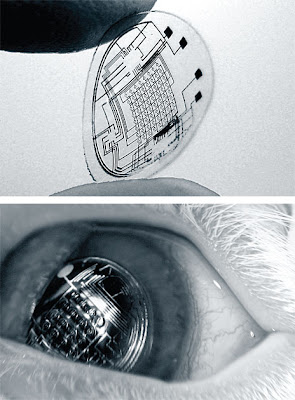Virtual Reality
虛擬現實,或虛擬實境(Virtual Reality),簡稱VR技術,也稱靈境技術或人工環境,是利用電腦模擬產生一個三度空間的虛擬世界,提供使用者關於視覺、聽覺、觸覺等感官的模擬,讓使用者如同身歷其境一般,可以及時、沒有限制地觀察三度空間內的事物。使用者進行位置移動時,電腦可以立即進行複雜的運算,將精確的3D世界影像傳回產生臨場感。該技術集成了計算機圖形(CG)技術、計算機模擬技術、人工智慧、感測技術、顯示技術、網路并行處理等技術的最新發展成果,是一種由計算機技術輔助生成的高技術模擬系統。
Virtual reality is an environment which is produced by a computer and seems very like reality to the person experiencing it.
虛擬現實是一種藉著電腦做出類似現實環境的技術,大部分的人都非常喜歡體驗它。
virtual ['vɝtʃuəl]
1. 很接近的;幾乎…的;事實上的;實際上的;實質上的
2. (通過計算機軟件)模擬的,虛擬的
reality [rɪ'ælətɪ]
1.現實;實際情況
2.事實;實際經歷;見到的事物
in reality 實際上;事實上
IPTV

互動式網路電視(IPTV)是通過數位電視服務藉由使用網絡連線架構方法和網際網路系列通訊協定封包式網路的一個系統,例如,Internet和寬頻網路擷取網路,取而代之傳統的通過無線電頻率廣播傳送,衛星信號,電纜電視(有線電視)形式。
IPTV services may be classified into three main groups: live television, time-shifted programming, and content (or video) on demand. It is distinguished from general Internet-based or web-based multimedia services by its on-going standardizationprocess (e.g., ETSI) and preferential deployment scenarios in subscriber-based telecommunications networks with high-speed access channels into end-user premises via set-top boxes or other customer-premises equipment.
IPTV業務可分為三大類:電視直播,時光平移(預約錄影功能),以及內容(或視頻)的需求。它不同於一般的以網際網路為基礎或使用網頁式的介面來操作的多媒體服務,經由高速有線頻道進行的標準化程序(例如,ETSI)和優惠部署方案的用戶為基礎的電信網路,到終端使用者住宅設置機頂盒或其他客戶端設備。
Arduino

Arduino can be used to develop stand-alone interactive objects or it can be connected to a host computer. A typical Arduino board carries the controller, some digital and analogue I/O lines, and a serial or USB interface to the host. This host is used for both programming the board, and run-time interaction with the Arduino. Arduinos themselves generally do not have networking facilities, but it is common to combine one or more Arduinos with a networked host, using the Arduino as hardware controllers and the host as a network or user interface. Host interfacing is simple, since the host software may be written in a variety of languages. A popular language is Processing, but other languages that can access the serial connection are Max/MSP, Pure Data, SuperCollider, ActionScript, and Java
Reactable
The Reactable is an electronic musical instrument with a tabletop Tangible User Interface that has been developed within the Music Technology Group at the Universitat Pompeu Fabra in Barcelona, Spain by Sergi Jordà, Marcos Alonso, Martin Kaltenbrunner and Günter Geiger.
Reactable是一種電子樂器與有形桌面的用戶界面,ReacTable是由西班牙巴塞隆納大學音樂科技團隊所製作。
Basic operation
基本操作
The Reactable is a round translucent table, used in a darkened room, and appears as a backlit display. By placing blocks called tangibles on the table, and interfacing with the visual display via the tangibles or fingertips, a virtual modular synthesizer is operated, creating music or sound effects.
Reactable是一個圓形半透明桌面,用在黑暗的房間,並為一個背光顯示屏。界面與視頻顯示通過有形的物體或指尖,使用虛擬模塊對機器操作,創造出音樂或聲音效果。
Augmented Reality in a Contact Lens

AR擴增實境隱形眼鏡
Source:(IEEE Spectrum:Augmented Reality in a Contact Lens)
(http://spectrum.ieee.org/biomedical/bionics/augmented-reality-in-a-contact-lens/0?t)
--
BY Babak A. Parviz // September 2009
The human eye is a perceptual powerhouse. It can see millions of colors, adjust easily to shifting light conditions, and transmit information to the brain at a rate exceeding that of a high-speed Internet connection.
人類的眼睛具有非常強大的功能,他可以分辨數以百萬計的顏色,調整各種光線條件,並超快速且有效率地把各種信息經由神經網路傳送到大腦
But why stop there?
In the Terminator movies, Arnold Schwarzenegger’s character sees the world with data superimposed on his visual field—virtual captions that enhance the cyborg’s scan of a scene. In stories by the science fiction author Vernor Vinge, characters rely on electronic contact lenses, rather than smartphones or brain implants, for seamless access to information that appears right before their eyes.
在電影「魔鬼終結者」,主角阿諾史瓦辛格的眼前有許多虛擬的數據及圖像不斷地疊加在他的視野裡;作者弗諾文奇的科幻小說裡,就是依靠電子隱形眼鏡,而不是智慧型手機或是大腦植入物,讓眼睛持續地捕捉訊息並傳送到大腦。
These visions (if I may) might seem far-fetched, but a contact lens with simple built-in electronics is already within reach; in fact, my students and I are already producing such devices in small numbers in my laboratory at the University of Washington, in Seattle [see sidebar, "A Twinkle in the Eye"]. These lenses don’t give us the vision of an eagle or the benefit of running subtitles on our surroundings yet. But we have built a lens with one LED, which we’ve powered wirelessly with RF. What we’ve done so far barely hints at what will soon be possible with this technology.
這些願景如果要馬上實現似乎有點牽強,但是隱形眼鏡內置簡單的電路裝置已經指日可待,實際上,我和我的學生們現在已經小量地在生產這種裝置,在我們位於華盛頓大學的實驗室裡;我們建立了一個鏡頭,採用了一些LED以及無線射頻技術,這些都暗示著在不久後我們可以利用這項技術。
Conventional contact lenses are polymers formed in specific shapes to correct faulty vision. To turn such a lens into a functional system, we integrate control circuits, communication circuits, and miniature antennas into the lens using custom-built optoelectronic components. Those components will eventually include hundreds of LEDs, which will form images in front of the eye, such as words, charts, and photographs. Much of the hardware is semitransparent so that wearers can navigate their surroundings without crashing into them or becoming disoriented. In all likelihood, a separate, portable device will relay displayable information to the lens’s control circuit, which will operate the optoelectronics in the lens.
要製造這樣的東西並讓他們成為一個系統,需要集控制電路、通訊電路和微型天線於一身,並運用定做的光電器件。這些組件將包含數百條發光二極管,這將是造成圖像顯示在眼睛前面的關鍵;大部分的硬體組件都呈半透明,配戴者可以看清楚周圍的環境,而不會迷失方向。
These lenses don’t need to be very complex to be useful. Even a lens with a single pixel could aid people with impaired hearing or be incorporated as an indicator into computer games. With more colors and resolution, the repertoire could be expanded to include displaying text, translating speech into captions in real time, or offering visual cues from a navigation system. With basic image processing and Internet access, a contact-lens display could unlock whole new worlds of visual information, unfettered by the constraints of a physical display.
這些東西並不需要非常複雜,他們是有益的,他們可以幫助聽力受損的人,或是被納入電腦遊戲裝置的一項指標,隨著更多的顏色和分辨率的提高,進而可以擴大到顯示一整個文件,或是提供溝通時的即時翻譯字幕,或提供視覺線索、導航系統;基本的圖像處理可以跟網路連接,我們可以開啟全新視覺訊息獲取管道,而不受物裡限制。
Besides visual enhancement, noninvasive monitoring of the wearer’s biomarkers and health indicators could be a huge future market. We’ve built several simple sensors that can detect the concentration of a molecule, such as glucose. Sensors built onto lenses would let diabetic wearers keep tabs on blood-sugar levels without needing to prick a finger. The glucose detectors we’re evaluating now are a mere glimmer of what will be possible in the next 5 to 10 years. Contact lenses are worn daily by more than a hundred million people, and they are one of the only disposable, mass-market products that remain in contact, through fluids, with the interior of the body for an extended period of time. When you get a blood test, your doctor is probably measuring many of the same biomarkers that are found in the live cells on the surface of your eye—and in concentrations that correlate closely with the levels in your bloodstream. An appropriately configured contact lens could monitor cholesterol, sodium, and potassium levels, to name a few potential targets. Coupled with a wireless data transmitter, the lens could relay information to medics or nurses instantly, without needles or laboratory chemistry, and with a much lower chance of mix-ups.
除了視覺加強之外,監測使用者生理狀態的功能在未來也可能是一個巨大的市場,我們已經建立幾個簡單的傳感器,可以檢測出一個分子的濃度,例如葡萄糖。傳感器內建的顯示器能讓患有糖尿病的配戴者隨時監測血糖濃度,而不需要刺破手指。關於葡萄糖檢測器,我們正在評估有可能在未來5~10年內出現。




